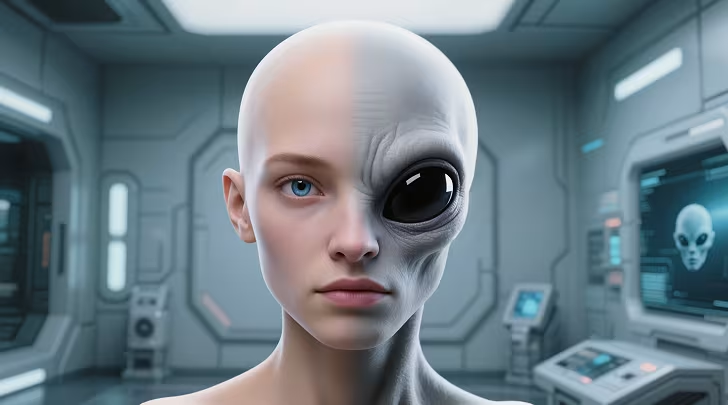Extratempestrial Hypothesis
Dr. Michael P. Masters, a professor of biological anthropology at Montana Technological University, has gained attention in UFOlogy for his provocative “Extratempestrial Model.” This hypothesis posits that UFOs and so-called aliens are not extraterrestrial beings from distant planets but future human descendants who use time travel to visit and study their evolutionary past. Drawing on his expertise in hominin evolutionary anatomy, archaeology, and biomedicine, Masters argues that the physical and cultural traits of reported aliens—bipedal, large-brained, hairless, and linguistically capable—align with long-term trends in human evolution.
Masters’ work, detailed in books like Identified Flying Objects (2019) and The Extratempestrial Model (2022), combines anthropology, physics, and abductee accounts to propose that UFOs are advanced time-travel devices piloted by our progeny. While controversial, his multidisciplinary approach has sparked debate in both academic and UFO communities, challenging conventional extraterrestrial narratives and inviting scientific inquiry into the nature of UAPs. This post explores Masters’ background, theories, and impact on UFOlogy.
Academic Background
Dr. Michael P. Masters holds a Ph.D. in Anthropology from The Ohio State University (2009), specializing in hominin evolutionary anatomy, archaeology, and biomedicine. His research has focused on human craniofacial morphology, orbital anatomy, and long-term evolutionary trends like encephalization (brain size increase) and reduced facial prognathism. Before joining Montana Tech as a professor, he taught at The Ohio State University, Columbus State Community College, and Ohio Dominican University, covering biological and cultural anthropology, archaeology, and sociology.
Masters’ academic work, published in journals like Journal of Anatomy and American Journal of Physical Anthropology, examines the relationship between human ocular, orbital, and neurocranial structures. His expertise in human evolution informs his UFO research, where he applies anthropological principles to analyze reported alien morphologies as potential future human forms. His dual focus on mainstream anthropology and UFOlogy has made him a unique figure in both fields.
The Extratempestrial Model
The Extratempestrial Model, introduced in Identified Flying Objects and expanded in The Extratempestrial Model, suggests that UFOs are piloted by future humans who resemble “Greys”—bipedal, large-brained, hairless beings with advanced technology. Masters argues that these beings reflect evolutionary trends like neoteny (retention of juvenile traits) and technological advancement, consistent with human development over millennia. He cites abductee reports of telepathic communication and time-related anomalies (e.g., missing time) as evidence of time-travel technology.
Using an abductive approach, Masters infers that time travel better explains UFO phenomena than interstellar travel, given the logistical challenges of crossing vast cosmic distances. He acknowledges other hypotheses (e.g., trans-dimensional beings) but focuses on the anthropological plausibility of future humans studying their past. Critics argue the model lacks physical evidence, like recovered craft, but supporters praise its scientific rigor and novel perspective.
Key Publications
Masters’ UFO-related books include Identified Flying Objects: A Multidisciplinary Scientific Approach to the UFO Phenomenon (2019), which outlines his time-travel hypothesis using anthropology, astrophysics, and philosophy. The Extratempestrial Model (2022) delves into abductee accounts, analyzing cases like the Betty and Barney Hill incident to support his theory. Revelation: The Future Human Past (2023) presents the hypothesis in a satirical sci-fi format, blending fact and fiction to explore UFOs.
He has also co-authored papers like “The Cryptoterrestrial Hypothesis” (2024), which explores subterranean explanations for UAPs, though he later expressed skepticism about related claims like the Nazca mummies. His academic publications, such as those on human orbital morphology, complement his UFO work by grounding his speculative theories in empirical science. Masters’ books are praised for accessibility but criticized for speculative leaps.
UFOlogy Contributions
Masters has contributed to UFOlogy by advocating for scientific openness to UAP research. His appearances on podcasts like UAP Studies and media outlets like Fox News have popularized his Extratempestrial Model, earning praise from researchers like Jason Guillemette for its logical approach. He emphasizes the need for academia to engage with UFOs without stigma, arguing that reported phenomena warrant multidisciplinary study.
His focus on abductee experiences, such as those involving hybridization programs, suggests future humans may face reproductive challenges, prompting genetic studies of their ancestors. While some view his work as groundbreaking, others question its reliance on anecdotal accounts. Masters’ efforts to bridge anthropology and UFOlogy have nonetheless elevated the discourse, encouraging critical examination of UAP origins.
Legacy and Criticism
Dr. Masters’ legacy lies in his attempt to legitimize UFO research within academia, using his anthropological expertise to propose a novel time-travel hypothesis. His work has inspired discussions on human evolution, time travel, and UAPs, influencing both UFO enthusiasts and skeptics. However, critics argue his model lacks verifiable evidence, relying heavily on abductee narratives and theoretical projections of human evolution.
His cautious distancing from controversial claims, like the Nazca mummies, reflects a commitment to scientific credibility, but some UFOlogists criticize this as selective skepticism. Despite debate, Masters’ multidisciplinary approach challenges conventional UFO narratives, inviting further inquiry into the intersection of human evolution and unexplained phenomena. His work remains a thought-provoking contribution to UFOlogy’s evolving landscape.

